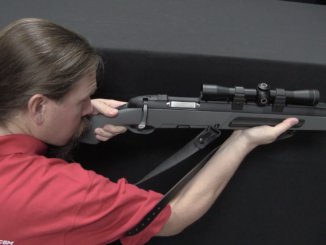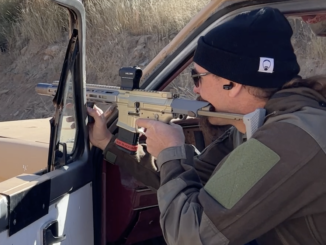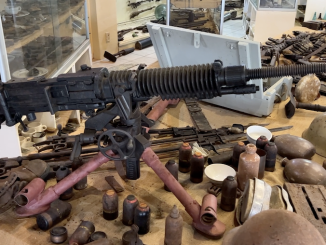The Tucker & Sherrard (and later Sherrard & Clark) is one of the more interesting Texas Confederate revolvers. The company initially was granted a contract with the Texas state government to provide 100 revolvers per month at $50 each, and took a total of $10,000 of investment capital from the state to start up their operation. However, aside from a few initial samples they never managed to deliver any guns to the state.
What appears to have been happening was that they were making guns, but selling them out the back door to private individuals, because the guns would easily bring $100 on the open market thanks to the arms shortages of the Confederacy. In the meantime, the company was delivering a whole series of excuses to Texas about why there were no deliveries – unavailable materials, conscripted workers, and fears of national CSA agents confiscating the guns. Texas finally had enough of this, and dissolved the contract, requiring the company to repay its seed capital with interest. Thanks to the serious inflation plaguing the Confederate currency, though, the repaid amount was only worth about half of its initial value.
This particular Tucker & Sherrard is one of the “low hammer” models, which handles much better than a standard Dragoon pattern revolver. Only three of these are known to exist (serial numbers 52, 54, and 56), and they seem to have been an experiment by the company for purposes unknown.




Ah, the intersection of guns and politics and history, can’t make this stuff up!
Thanks, Ian, for another great video!
Modern reproduction of Tucker & Sherrard Dragoon Revolver:
http://www.lodgewood.com/Tucker-Sherrard-Dragoon-Revolver_c_250.html
Apparently John M. Crockett was man which can make other to believe (and pay!), even despite many signals against.
John M. Crockett reminds me Dyrenkov
http://armor.kiev.ua/Tanks/BeforeWWII/dyrenkov/
designer of D-4 wheel-track-tank (early 1930s) which was totally unusable in both methods. He receive around 1000000 roubles, prototype was build which barely can move itself on wheels at factory concrete square, when on track it immediately break down, promised speed of 35km/h (on tracks) remain impossible dream.
Anyway Dyrenkov created new projected D-5 – it was bigger than predecessor (apparently it belong to man believing in rule: IF SOMETHING DOES NOT WORK MAKE IT BIGGER) and additionally it was not just wheel-track-tank but wheel-track-railroad-submarine-tank, he even get money, but it D-5 never go beyond mock-up stage.
We were in the middle of a Civil War (are any wars “civil”?) so I don’t reckon that the folks who seceded from the Union were too concerned with U.S. Patents out of Washington D.C.!
I’d call this a “Confederate era” pistol, (maybe not even that), since they don’t appear to have been issued to anybody in the Confederacy and instead sound more like a bit of war profiteering.
As for the lack of a bullet cut in the barrel extension, even with one, the cylinder has to be rotated slightly to bring the chamber opposite the rammer to ram it down.
Also, with the chamber halfway in back of the forward frame, getting a conical bullet in straight cold be even more fumblesome than usual.
Furthermore, by that time most revolvers on both sides were being loaded with pre-prepared consumable cartridges containing bullet and powder in one package. You shoved it in the chamber all at one go, rotated the cylinder until it was in line with the rammer, and rammed it home. You didn’t try to slip it in at an angle via the bullet cut; that would generally split the cartridge “skin”, dumping powder all over you and the revolver.
For all of the reasons listed above, I suspect the makers decided that the bullet cut was more cosmetic than actually useful, and sensibly left it off as an extra machining step that just wasn’t worth the bother.
cheers
eon
[making a futile attempt to load Tucker & Sherrard with paper cartridges] AAARRGH! CHEESE! [punches camera in frustration]
Give me a Remington Model 1858 and a few preloaded cylinders and I’ll be fine! Smith & Wesson revolvers with rim-fire cartridges also would do some good (patent trolling aside) as would a Lefaucheux pin-fire piece.
Weapon of choice scenario:
Not that I like ripping off spaghetti westerns, but if you had to get anything for that appointment at noon with the guys who insulted your mule, what would you bring to percussively rearrange their attitudes?
1. Colt Walker
2. Remington Model 1858
3. Smith & Wesson Model 1 1/2
4. Lefaucheux M 1858
5. Beaumont-Adams
6. Savage Navy Revolver
7. Le Mat
8. Break-action shotgun
9. Winchester 1866
10. Vetterli 1869
11. Or per the usual, screw the budget and add your favorite toys to this list.
This activity is completely voluntary. You are not required to pay the coffin maker if you do not wish to do so. Please keep any and all criticism of this post humane and free of foul language.
Thank you,
Cherndog
I never bought a Colt Walker replica because I pay for my powder, and think the charge is excessive.
Remington Model 1858 is the most accurate with the top strap of the frame, and the Le Mat would scare any drunk cowboy out of the saloon!
Having just watched “Sabata” and “Return of Sabata” on DVD, I can say pretty definitely that either the shotgun or the Winchester would be your best option.
First of all, a double-barrel loaded with buckshot (10 gauge and No. 0 being typical back then) will throw a lethal pattern out to 40 yards even from a relatively short (20″) cylinder bore. One hit will lam the brute with at least four to six pellets, each the size of a .36 revolver slug, and going significantly faster than most .36 percussion revolvers could push them out. And they would be arriving all at once, not one after the other.
One hit to the vitals generally decides the issue. BTW, this is how Doc Holliday killed Tom McLaury at the “Gunfight at the OK Corral”. (So called because it sounds better than “The ten-second shootout in the vacant lot next to Fly’s Photographic Studio”.)
https://en.wikipedia.org/wiki/Tom_McLaury
Other than the shotgun, the lever-action rifle or carbine has a greater capacity (10 to 15 rounds), can be fired more rapidly, is more accurate, and (due to a longer barrel allowing a full powder burn) hits harder than any handgun of the era. Particularly if (like Banjo) you’re up against more than one guy, the Winchester is the way to go.
(Choose your own stringed instrument to conceal it. I’ve seen some strange things hidden in acoustic guitars.)
While the Vetterli tube-magazine repeater matches the Winchester for capacity, and its 10.4 x 38R round hits a lot like the .45-75 Winchester it resembles in profile, the bolt-action simply cannot be repeat-fired as quickly as the lever-action. While bolt-actions generally win accuracy matches, they consistently finish dead last in RoF when up against not only semi-autos, but also lever guns and pumps.
So the hands-down winner is most likely the Winchester ’66. As Keith’s Third Law states, “Never bring a pistol to a rifle fight”. Corollary; A shotgun is often a viable option.
The handgun is an arm to be carried at all times in event of unexpected trouble. If you know for a fact that there will be a fight, you should naturally choose the most effective weapon, not necessarily the one that’s the most convenient to tote around all day.
cheers
eon
While I agree completely with your choices here, I would like to point out that straight-pull bolt-actions are at least as fast, if not faster to cycle than lever-action rifles. Of course none were available in the 1860s or 1870s, so they would not be contenders in this Cherndog scenario.
re. Break-Action shotguns
Here’s one for Forgotten Weapons:
UMC is said to have made the first shotgun shells in the U.S. in 1868. They were unloaded, primed, empty brass shells only. Loaded shells would not be sold by UMC until 20 years later.
So, here’s the question: In the U.S., what commonly available breach-loading shotgun were these shells being made for in 1868?
Popular culture would have us believe that Greener shotguns were around and about the U.S. at this time, but is this true? I have also heard that there were shotgun wielding cavalry troops in the Civil War, but I’ve always assumed these were muzzle-loading doubles of various sorts brought from home by the soldier. In a cavalry charge it would sure be easier to blast somebody with a shotgun than with a rifle or a pistol.
Hmm… If I’m not mistaken there was at least one double barreled shotgun whose breechblock opened in a similar manner to that of the trapdoor Springfield. I believe I found it in a book titled One Hundred Great Guns. Though of course my memory isn’t that good and the book is no longer available at my local library.
See Modern Breechloaders (1871) or The Gun and its Development (1897), both by W.W. Greener. (You can find either one, in PDF, for free, online, as they are long out of copyright.)
The break-action, double-barreled shotgun, in both outside hammer and hammerless persuasion, was basically fully developed in Europe and especially Britain by 1866. The original was the Lefaucheux pinfire of 1851 (yes, he did more than just revolvers). Various locking setups such as the Anson and Deeley and the Greener “triple-wedge lock” (developed by W.W.’s dad) were all perfected by 1865.
As for cartridges, the familiar “battery cup” cartridge (brass head with centerfire primer, paper, later plastic, case) was developed in 1859-60. By 1866 it was being used not just for shotguns, but for the British Army’s new 0.577in Snider-Enfield breechloading rifle.
Greener advocated coiled-brass cases over drawn-brass ones for rifles as well as shotguns at the time. By 1897 he’d learned better, and settled on the drawn-brass case for everything, even shotguns.
So yes, a double-barreled 12 gauge, 10 gauge, or whatever could easily be found in the 1870s, along with quite modern-appearing ammunition to fit it.
In fact, double-barreled breechloaders could have been used by Confederate cavalry in the Civil War if their purchasing agent in England, Caleb Huse, had thought of contracting for them.
(Now there’s a nasty thought.)
cheers
eon
I’ve heard about the developments overseas, but I’m wondering specifically about the U.S. _before_ 1868 that would have prompted UMC to start the production and sale of empty shells. There had to be enough breech-loading shotguns in the U.S. by that date to produce a demand for domestically produced, loadable shells. I’m wondering what those would have been.
As for shotguns in the Civil War in the U.S., there are plenty of photos, here’s a few from a quick google search:
http://www.antiquearmsinc.com/images/double-barrel-percussion-shotgun-strohecker-civil-confederate-cofer-sutherland-kernaghan/double-barrel-percussion-shotgun-strohecker-civil-confederate-cofer-sutherland-kernaghan-33.jpg
https://c2.staticflickr.com/6/5534/14378949850_76c8ec4100_b.jpg
https://memory.loc.gov/service/pnp/ppmsca/34300/34331r.jpg
http://www.thomaslegion.net/sitebuildercontent/sitebuilderpictures/civilwardoublebarrelshotgunbowieknife.jpg
http://neveryetmelted.com/wp-content/uploads/2015/06/BlackConfederate1.jpg
http://gunsoftheoldwest.com/wp-content/uploads/2013/02/4_gowfinal1.jpg
https://c1.staticflickr.com/7/6045/6883288310_4372298a99_b.jpg
http://3.bp.blogspot.com/_k07pirzBU34/TDScra8n1sI/AAAAAAAAFGw/Kc2DSj2JePE/s1600/Confederateshotgun.jpg
https://s-media-cache-ak0.pinimg.com/236x/c7/f6/1d/c7f61d693f244f188f3b62cd23e28933.jpg
https://s-media-cache-ak0.pinimg.com/564x/76/3f/2c/763f2cceeab83935121b0fc1af261596.jpg
Lots of stories about troops using shotguns in the war, just not anything that I’ve seen that mentions breech-loading shotguns as such.
“5. Beaumont-Adams”
Probably best of all percussion revolvers, as it was reliable double action in modern sense (single mode: cock hammer, pull trigger, double mode: pull trigger)
When original Beaumont Adams fire .442 bullet, Massachusetts Arms Company produced it version in BELT SIZE (for .36 bullet, named Massachusetts Arms Company Adams Patent Revolver) and POCKET SIZE (for .31 bullet, named Massachusetts Arms Company Adams Patent Pocket Revolver)
https://www.collegehillarsenal.com/shop/product.php?productid=498
Cite opinion of user:
“I think very favourably (sic) of the arm….as being well adapted to Military use, and as the price is considerably less than….the Colt Pistol, to which it is quite equal and, in some respects, in my opinion superior.”
—
“11. Or per the usual, screw the budget and add your favorite toys to this list.”
If it is possible: Colt pump-action rifle LIGHTNING, as say advert phrase: Nothing was faster than lightning, if not available yet then get Norwegian Krag–Petersson repeating rifle
Rifle or shotgun. The pistol is only used to fight your way back to the long gun you should have never left behind
i figured out the reason for using roman numerals on the screw heads! since they only marked the last digit, it was easier than using Arabic numerals! i.e. they took a cold chisel and tap-tap, your done. while using a stamp with an Arabic numeral was far more difficult on a tiny screw.